Creating a minimum viable product (MVP) is crucial for validating your idea and demonstrating its potential success in your market, especially for startups entering competitive landscapes.
How do you go about building an MVP? What are its key benefits?
In this article, we provide a comprehensive guide to successfully building an MVP, addressing these questions and more.
Let’s explore
What is an MVP?
First, let’s cover the basics.
A minimum viable product (MVP) is a bare-bones version of your software product that includes only its essential features.
It’s the best idea validation tool that will show you if there’s genuine market demand for your app.
But, building an MVP isn’t just about putting together a working app and calling it a day.
It’s about creating a usable and appealing product that will resonate with your users and meet their needs.
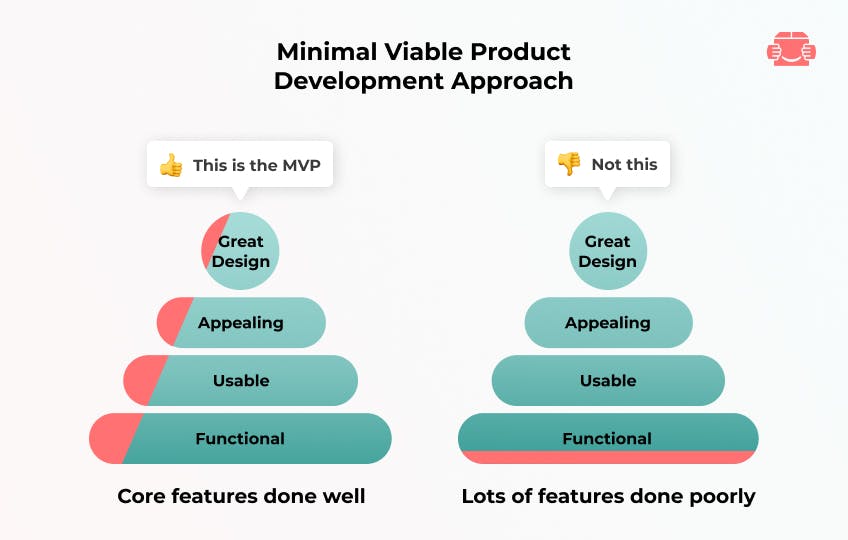
source: Voypost
And you can build various types of MVPs, like:
- Single-feature MVP – As the name implies, a single-feature MVP has only the main feature of your product and it’s one of the most common MVP types out there
- Pre-order MVP – a pre-order MVP is when you take pre-orders and crowdfund to generate a buzz before you actually build your product
- Concierge MVP – a concierge MVP looks and acts just like a regular app, but the back-end is run manually by humans
- Fake door MVP – fake door MVPs are usually landing pages built to gauge market interest before building an MVP or prototype
In a nutshell, building an MVP is the best way to make sure your idea can be successful in your target market.
And that’s why it’s such a popular approach.
Benefits of MVP development for startups
Now, let’s go over some of the top benefits of MVP development for startups.
Faster time to market
Speed is one of the defining advantages startups have over traditional companies.
Developing an MVP will help you be even faster and get your product to market before your competitors.
As a startup, that should always be your main goal.
And you shouldn’t worry about if your product is perfect before launch – like LinkedIn co-founder and executive chairman, Reid Hoffman, said:
“If you are not embarrassed by the first version of your product, you’ve launched too late.”
But, why exactly is being quick to market so important?
If you’re in a new and competitive market, getting to market early will help you capture a market share and start building relationships with users before anyone else.
Also, you’ll start learning from user feedback sooner which will help you refine your product faster.
And that will help you stay ahead of the competition.
Cost-efficient development
Another reason you should build an MVP as a startup is that it’s a much more cost-efficient approach to software product development.
And in a tough economic environment with rising interest rates and tighter budgets, cost-efficiency is more important than ever.
So, for startups, cost-efficient development is not just a good strategy but a necessity.
Building an MVP is the best way to do just that.
That’s because when you build an MVP, you only focus on building your product’s core features.
And that’s one of the best ways you can reduce development costs.
It will help you keep your product’s development focused and keep costs under control.
And that’s exactly what you should want.
Validates your idea
Building an MVP as a startup is one of the best ways you can validate your idea.
Validating your idea will show you if your product can succeed in the market or if you need to pivot to another idea.
This can save you a lot of time and money if your initial idea doesn’t cut it and doesn’t achieve product-market fit.
And achieving a product-market fit is key to your product’s success.
The stats prove how important product-market fit is, too.
According to CB Insights, having no market need is one of the top reasons why startups fail:
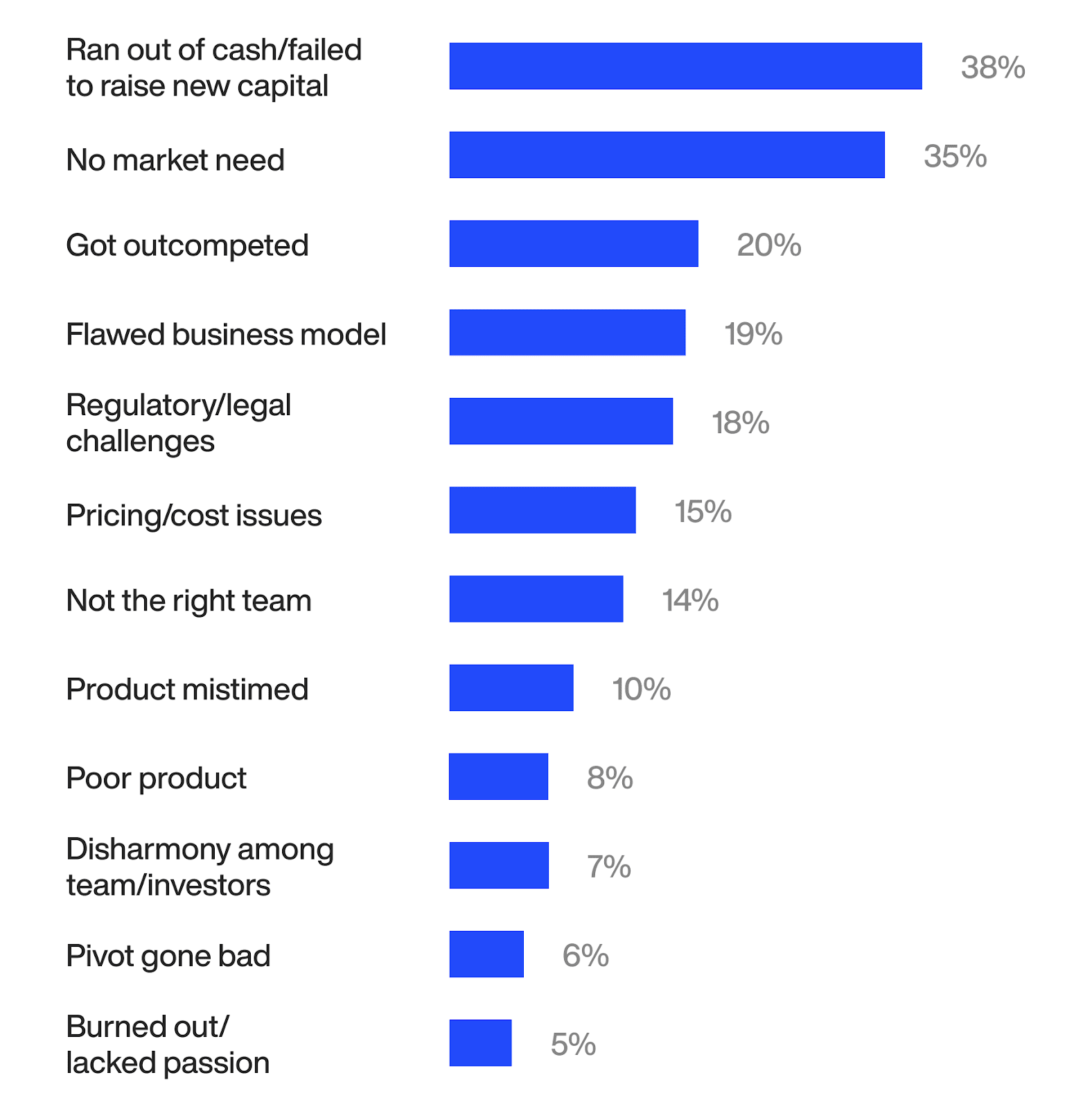
source: CB Insights
So, validating your idea and getting a product-market fit is incredibly important.
And building an MVP will help you do just that.
How much does it cost to build an MVP for your startup?
Unfortunately, there’s no one-size-fits-all answer on how much an MVP will cost you.
That’s because the cost of MVP development depends on a number of factors, like:
- Your target platform(s)
- The complexity of your design
- The features you include
- The tech stack you use
- The size and experience of the development team
For example, a fintech app MVP will be significantly more expensive than an MVP for a simple communication app.
But, depending on complexity, on average an MVP will cost you:
- A simple MVP – $15,000-40,000$
- A medium complexity MVP – $50,000-80,000$
- A complex MVP – $100,000+
And there’s another major factor that will influence the cost of your MVP – quality.
Going for the cheapest option can end up costing you a lot more in the long run due to quality issues.
So, an experienced software product development company might quote you a higher initial price, but they’ll get it right from the start.
And that’s exactly what you need when building an MVP.
How to build an MVP for your startup: step-by-step guide
Here, we’ll show you how to build an MVP for your startup, step-by-step.
Start with market research
The first step you should take when building an MVP for your startup is researching your market.
Without market research, you won’t be able to build a successful MVP.
It will help you find out everything you need to know about your target market and help you identify your target audience.
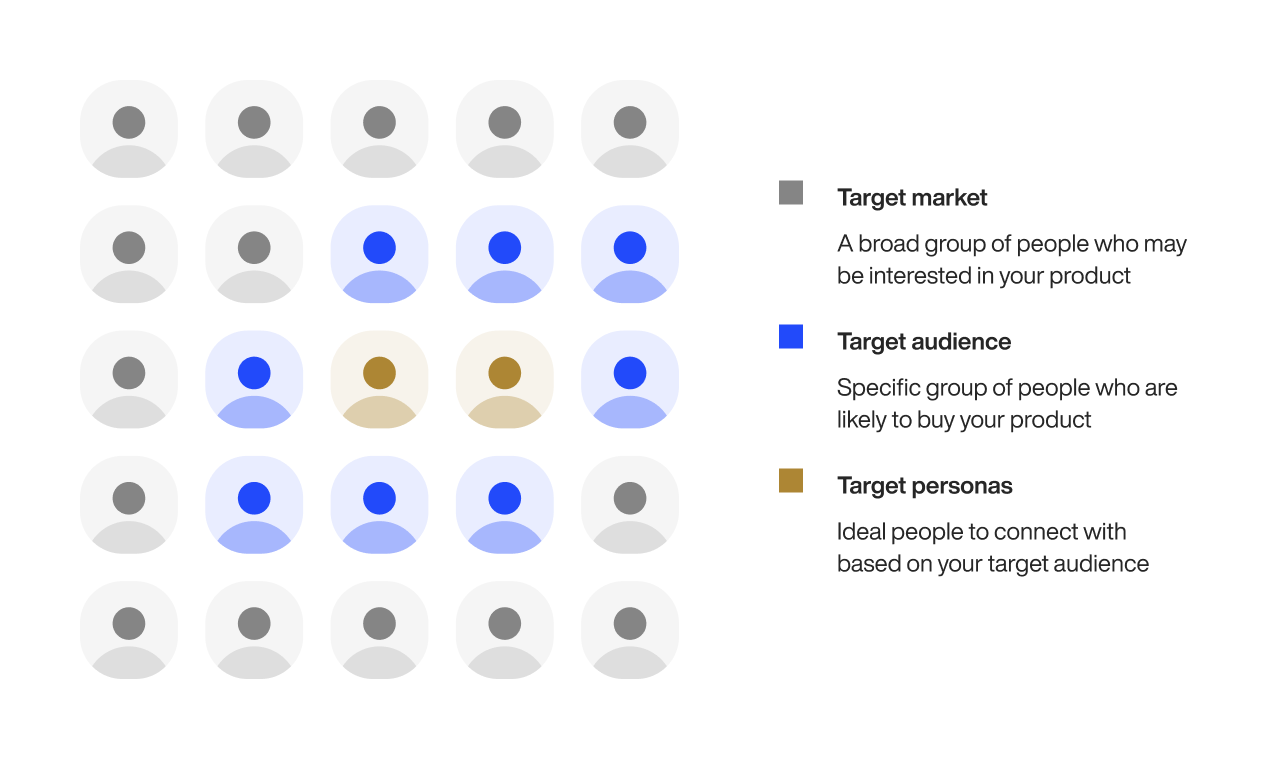
And you need that if you want to build a successful product.
Like Philip Kotler, marketing professor and consultant, said:
“There is only one winning strategy. It is to carefully define the target market and direct a superior offering to that target market.”
If you’ve done it right, after you’ve finished market research you’ll know:
- Who your competitors are
- How they position themselves in the market
- The size and growth dynamics of your target market
- Market gaps you can exploit with your product
In short, market research will help you position your MVP and get to a product-market fit.
And that’s why it’s so important.
Key tips
- Do competitive analysis – analyzing your competitors will help you better position your MVP and identify gaps in the market you can exploit
- Keep an eye out on global trends – make sure to analyze global trends outside of your target market to find new opportunities
- Come up with a unique value proposition – you need to determine what sets your product apart from the competition and why users should choose your product
Research your users
If you don’t know your users, you can’t build a product that meets their needs.
And that’s why user research is so important when building an MVP for your startup.
During user research, you’ll identify:
- Their behavior
- Their pain points
- Their unmet needs
This will help you build an MVP that actually resonates with them and solves their problems.
So, how should you do user research?
First, you need to set clear research goals that will keep your research focused and give you the best results.
Next, you need to choose the user research methods you want to use – luckily, there’s a huge number of different research methods out there:
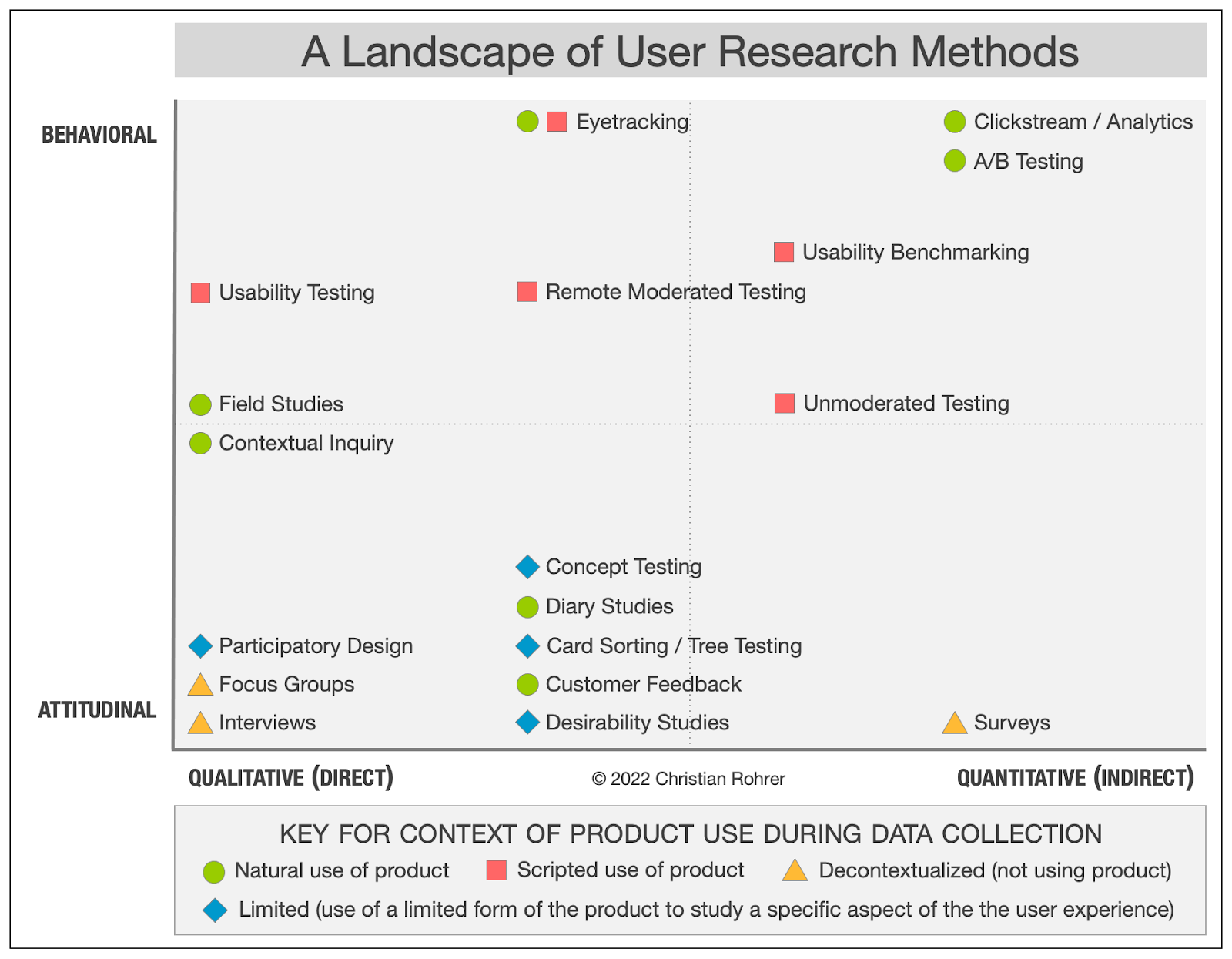
source: Nielsen Norman Group
Of course, you won’t use all of these methods, just ones that help you achieve the research goals you’ve set.
But, you should use a mix of qualitative and quantitative research methods to get the best results, like:
- User interviews
- Surveys
- A/B testing
- Questionnaires
- Focus groups
The user research you do will set the stage for the rest of your MVP’s development.
And that’s why you need to nail it from the start.
Key tips
- Use a variety of research methods – you should use both qualitative and quantitative research methods to get the most accurate insights from your users
- Create detailed personas – creating detailed buyer/user personas will help you keep your users on top of your mind throughout the MVP development process
- Make user journeys – user journeys help you understand how your users actually interact with your product and identify their pain points
Define your MVP’s core features
Defining its core features is the most important step when building an MVP for your startup.
And there’s a good reason for that.
According to Pendo, 80% of features in a typical software product are rarely or never used.

source: Pendo
And the point of building an MVP is to build a product with only the most essential features.
So, clearly defining your MVP’s core features is an absolute must – but, how do you do it?
First, you should come up with a list of features you might want to include and ask questions like:
- Can this feature meet our users’ needs?
- Is this feature technically feasible?
- Is it aligned with our business goals?
- Do our competitors’ products have this feature?
This will help narrow down your initial list, but it’s just the start.
To really nail down your MVP’s core features, you should use feature prioritization methods like:
- MoSCoW (Must have/Should have/Could have/Won’t have)
- RICE (Reach/Impact/Confidence/Effort)
- Value vs. effort
- Kano
For example, here’s how the MoSCoW method works:
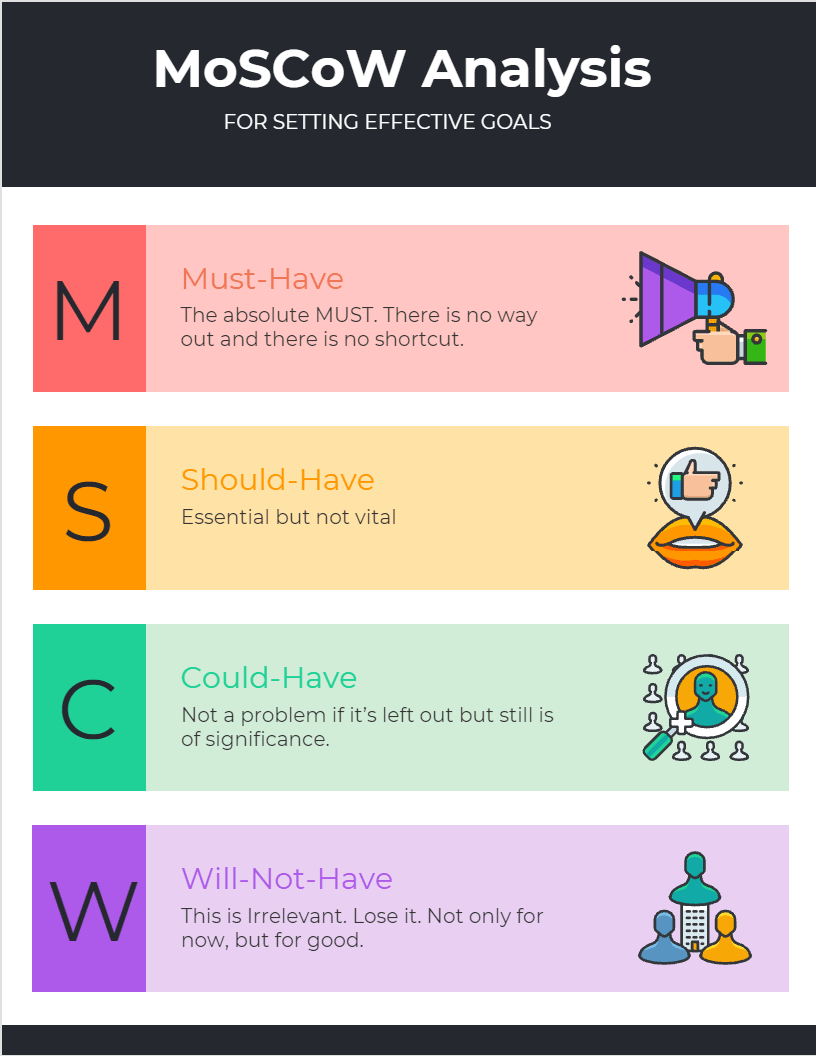
source: Project Cubicle
With these methods, you’ll be able to objectively evaluate and decide which potential features your MVP should have.
And that’s how you build a successful MVP.
Key tips
- Use various prioritization methods – you should use a number of different prioritization methods (e.g. RICE, MoSCoW, Value vs. effort) to find the most impactful features for your MVP
- Keep it simple – you should aim to keep your MVP as simple as possible, without any unnecessary features
- Focus on the core problem – any features you add should help solve the core problem your users face and
Design and prototype your MVP
Your MVP’s design is possibly its most important element.
A great design and user experience (UX) can mean the difference between failure and success.
The stats back that up, too.
According to Forrester, a good user interface (UI) can increase conversion rates by up to 200%.
And for each $1 you invest in user experience (UX), you get $100 in return – that’s an ROI of 9,900%, if you get it right.
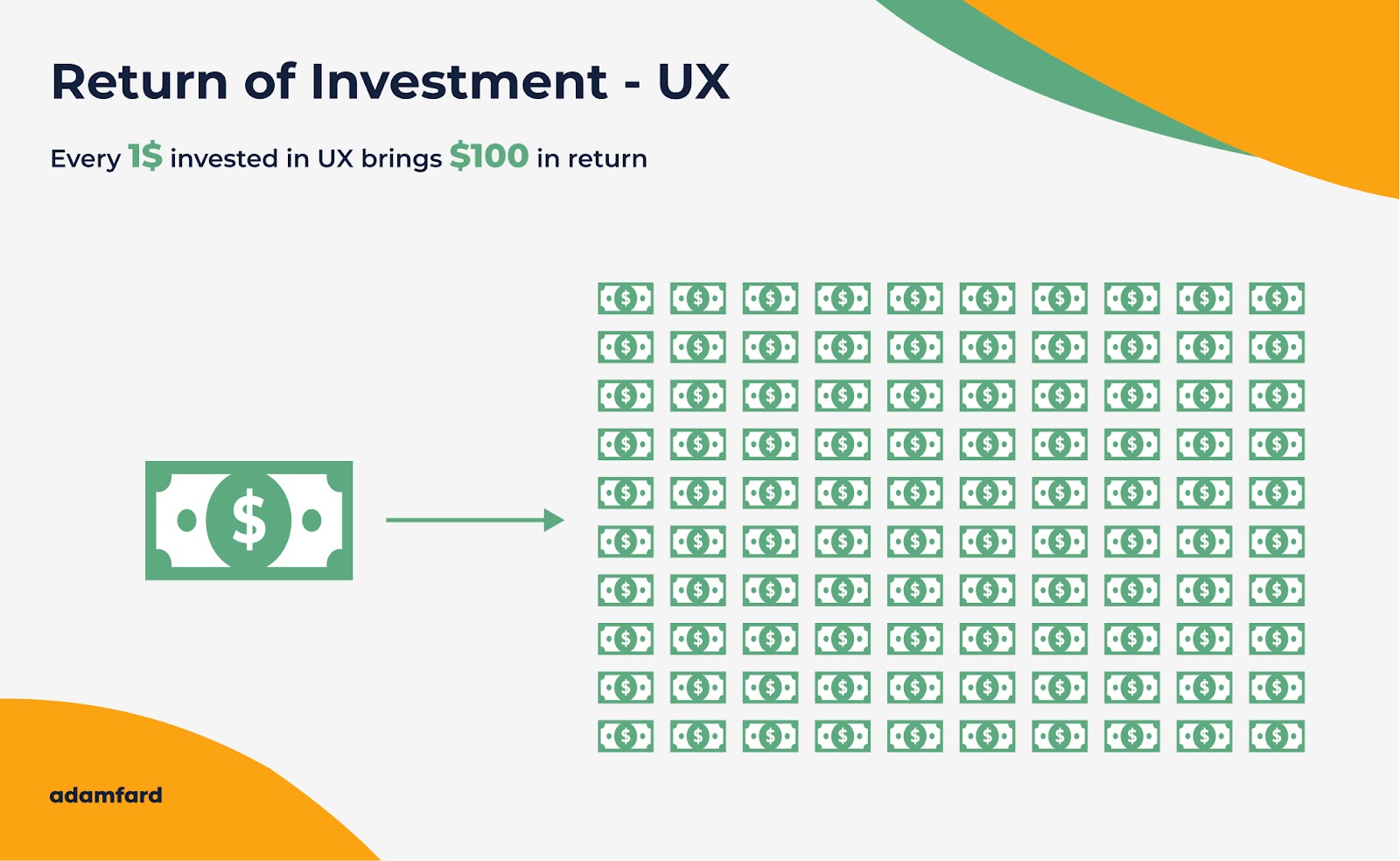
source: Adam Fard
o, a great design is important – but, what does the design process look like?
Typically, it’s done in 5 steps:
- User research
- Wireframing
- Making a mockup
- Prototyping
- Usability testing
We’ve already covered how you should approach user research in detail.
But, you should keep in mind that your research results will guide the rest of your design process.
Your design has to solve your users’ pain points and meet their needs – otherwise, it won’t hit the mark.
And the first step to achieving that is creating a wireframe.
A wireframe is an initial sketch of your MVP’s UI – it can even be a simple, hand-drawn sketch.

It’s a low-cost, quick way to test out ideas and concepts before actually committing to a design.
Once you’ve wireframed your MVP, you should make a mockup – a mockup is a static representation of your MVP’s design.
And after you get feedback on your mockup, you should build a prototype.
Your prototype can be both low-fidelity and high-fidelity, here’s a breakdown of the differences between the two:
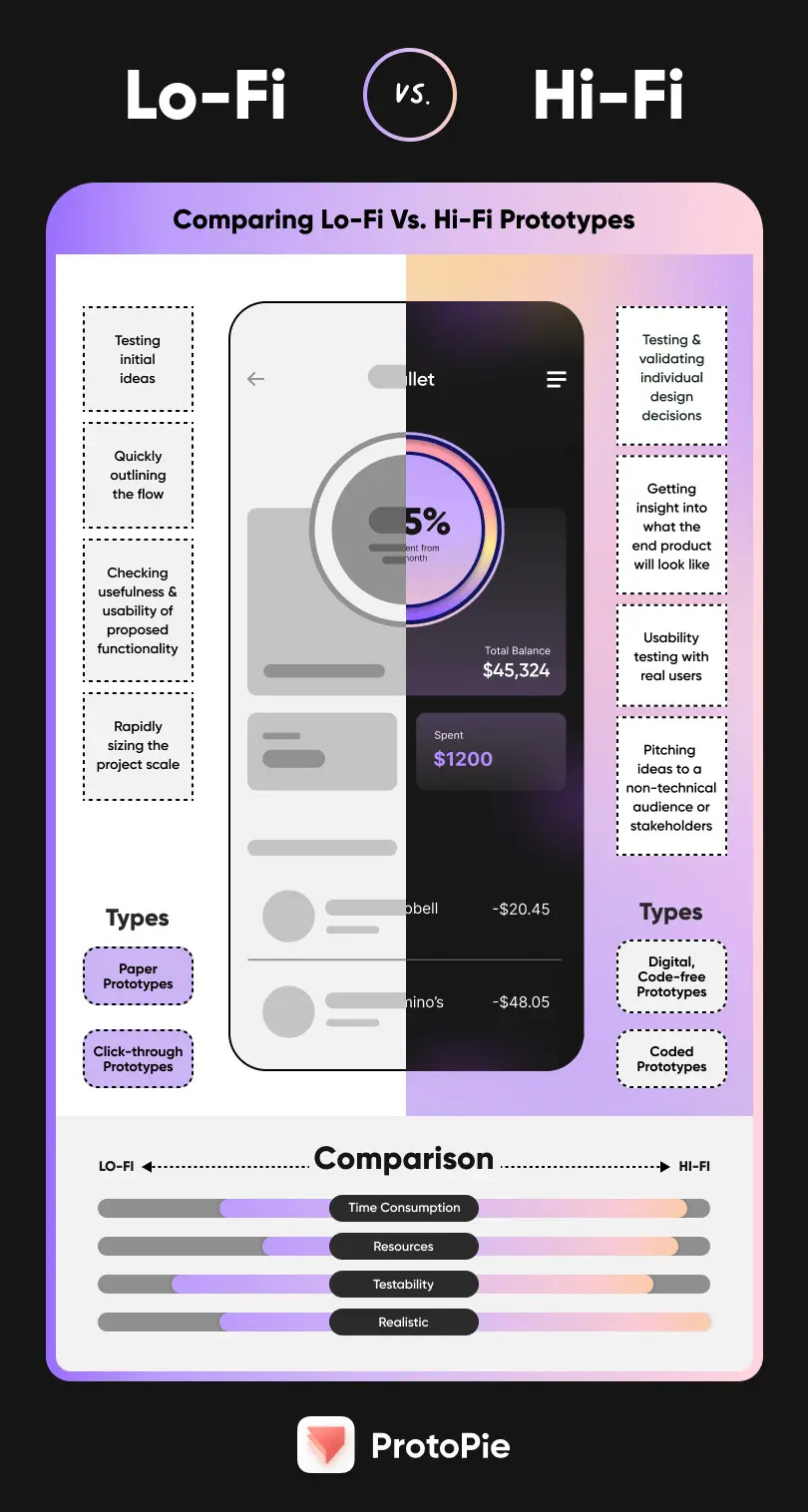
source: ProtoPie
But, you’ll need a high-fidelity prototype for the final step – usability testing.
Usability testing is where your users test out your MVP’s design and UX, which will help you catch any flaws or issues that you might have missed.
And once you’ve ironed out the issues, you can hand off your design to your engineering team and start building your MVP.
Key tips
- Create a design system – creating a design system will help you keep your MVP’s look and feel consistent
- Use off-the-shelf solutions – using pre-made templates and UI kits is a good way to cut costs and speed up development without sacrificing quality
- Do usability testing with real users – getting real users to do usability testing will help you find any usability problems you might otherwise miss and improve your MVP’s UX
Build your MVP
This step is where the magic happens and your MVP comes to life.
It’s key you get it right if you want a successful MVP.
So, how do you do that?
Your first step should be to write a software requirements specification (SRS) document – think of it like a blueprint that will guide your development process.
Your SRS should cover your MVP’s functional and non-functional requirements.
Functional requirements cover what your MVP does and non-functional requirements cover how it does it.
Here’s a more detailed breakdown of both:

Next, you need to choose the right tech stack.
A tech stack is the set of technologies used to build your MVP – here’s what a typical one looks like:
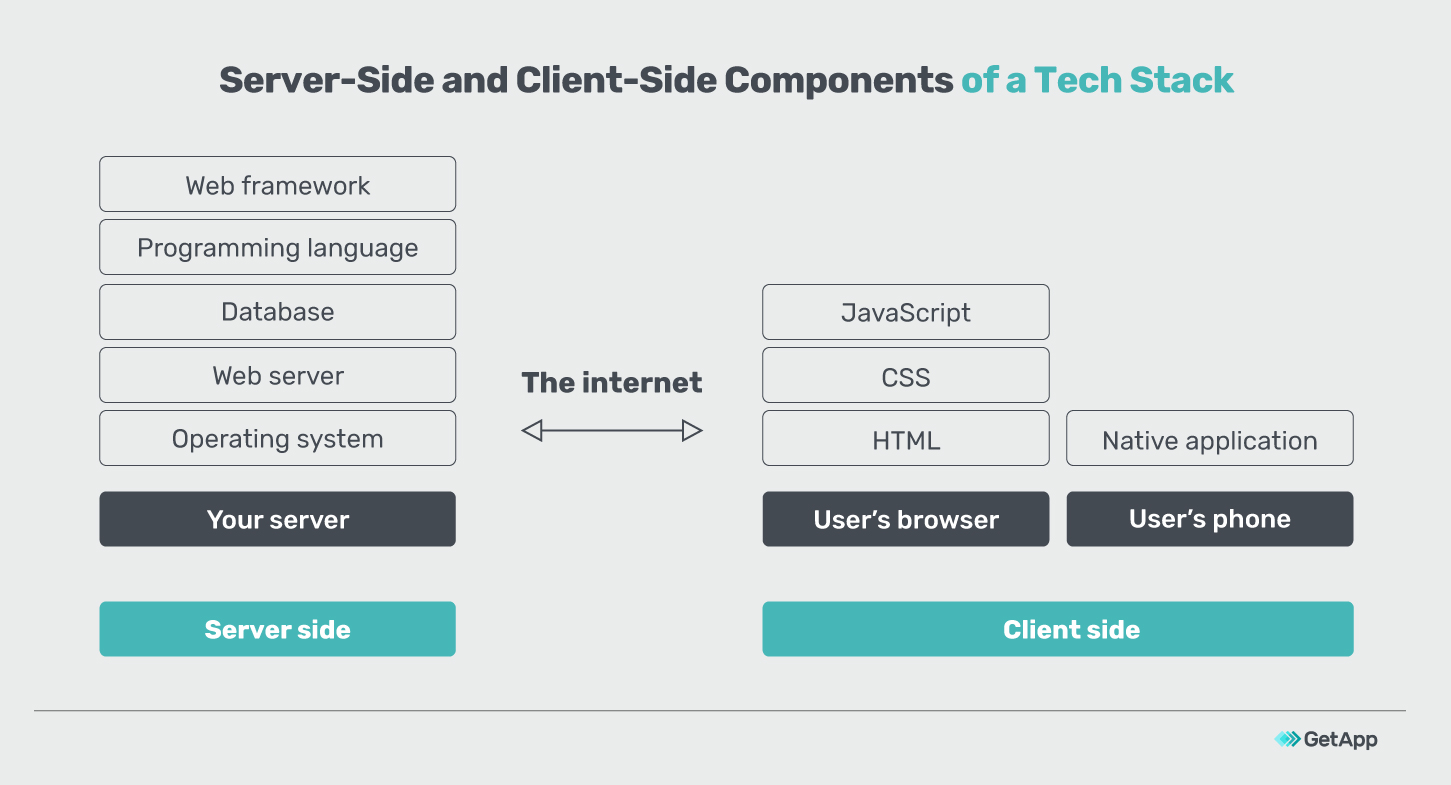
source: GetApp
Also, you need to pick the right development methodology.
When building an MVP, Agile methodologies like Scrum and Kanban are the best choice.
Scrum in particular stands out – 81% of Agile teams use Scrum or a Scrum hybrid.

And there’s a good reason for that – Scrum divides your development into mini development cycles called sprints.
This helps your team work more efficiently and iterate quickly.
And that’s exactly what you want when building your MVP.
Key tips
- Use open-source tools and frameworks – using open-source tools and frameworks will help you cut down on development costs
- Use Agile methodologies – Agile methodologies will help you iterate faster and speed up development, which will get your MVP to market faster
- Start testing early and often – if you start testing early, you’ll catch bugs and issues as soon as they happen, which will save you a lot of money
Launch your MVP and set up a feedback loop
Once you’ve finished building your MVP, your final step is launching it.
This is a make-or-break moment for your MVP and you only have one chance to do it right.
And what you need is a detailed launch plan.
Here’s how you create one:

source: Smartsheet
But, the launch is just the start – you need to be ready to iterate on your MVP.
To do that, you need to set up a feedback loop.
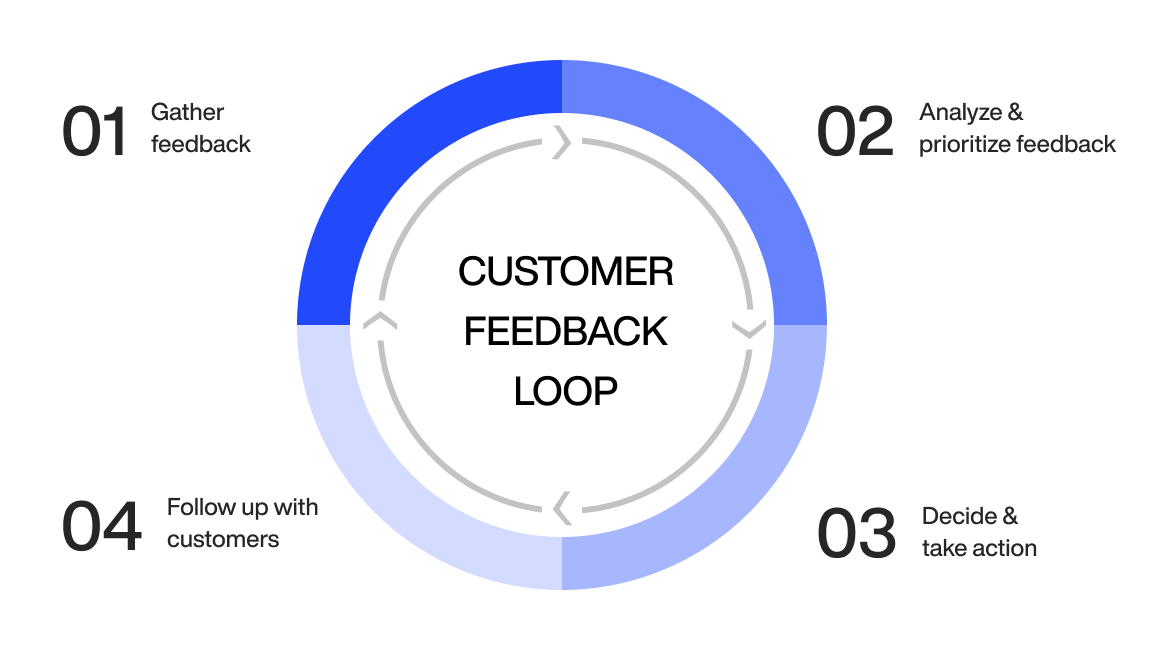
The purpose of a feedback loop is to continuously collect, analyze, and iterate on user feedback.
Setting it up will allow you to make the most of your users’ feedback and help you effectively iterate on your MVP.
The sooner you get to the feedback loop, the sooner you can give users what they actually want.
Just make sure you gather feedback from multiple channels, like:
- Feedback forms
- In-app surveys
- Focus groups
- User interviews
- Questionnaires
Once you’ve analyzed and iterated on the feedback, you should follow up with your users and repeat the cycle again.
And that’s how you’ll set your product up for long-term success.
Key tips
- Set up multiple feedback channels – you should set up multiple feedback collection channels to get the most out of your feedback loop
- Be prepared to iterate quickly – once you set up your feedback loop, you should immediately start iterating on your MVP
- Create a detailed launch plan – a detailed launch plan will ensure your MVP’s launch goes off without a hitch
MVP development for startups: FAQs
What is an MVP?
A minimum viable product (MVP) is the first, stripped down version of your product with only the essential features included.
It’s one of the best idea validation tools you can use to prove your idea can succeed in your market.
What are the benefits of building an MVP for startups?
The benefits of building an MVP for startups are:
- Faster time to market
- Cost-efficient development
- Validating your idea
How do I build an MVP for my startup?
The steps you should follow to build your MVP are:
- Start with market research
- Research your users
- Define your MVP’s core features
- Design and prototype your MVP
- Build your MVP
- Set up a feedback loop and launch your MVP
Need help with an MVP for your startup?
Do you have a startup with a great idea but don’t know how to start building your MVP?
Don’t worry, we’ve got you covered.
We can help you build your MVP from scratch, from validating your idea all the way to launch – all in under 6 months.



